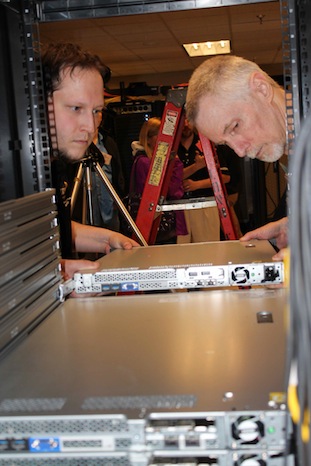BTN.com staff, BTN.com staff, June 1, 2015
 The saying ?Rome wasn?t built in a day? is generally taken to mean that complex systems and solutions can?t be developed quickly. But whoever came up with the aphorism clearly wasn?t familiar with Purdue University?s ?Install Day.?
The saying ?Rome wasn?t built in a day? is generally taken to mean that complex systems and solutions can?t be developed quickly. But whoever came up with the aphorism clearly wasn?t familiar with Purdue University?s ?Install Day.?
That event took place on May 8, when a veritable village of Purdue staff and volunteers assembled a research supercomputer named Rice in less than 24 hours and immediately put it to use, a shining demonstration of team-building and resourcefulness. Take that, Romans!
?I think it?s novel to see a university do something in this kind of space in an organized way,? said Gerry McCartney, Purdue?s system chief information officer.
McCartney, also Purdue?s vice president for information technology, and Olga Oesterle England, professor of information technology, said the annual ?Install Day? showcases a normally unseen aspect of campus activity.
The moniker is a bit deceiving: To make the computer-in-a-day project a success, months of prep work and planning take place in advance of the actual event.
?It?s like raising a barn,? McCartney said. ?We?ve been preparing three months for the building, and a lot of things happen a couple of days before the building [starts].?
This was the eighth-annual Install Day. The event is spearheaded by Information Technology at Purdue (ITaP) under the school?s Community Cluster Program. According to McCartney, some 200 individuals were involved in the actual building process of the machine, named after John R. Rice, the W. Brooks Fortune Distinguished Professor Emeritus of Computer Science at Purdue.
According to ITaP, Rice is a general-purpose computer system that?s equipped to solve a wide range of scientific problems. The group reports more than 150 Purdue research labs and hundreds of faculty and students make use of supercomputing clusters to make all sorts of breakthroughs, such as developing new cancer treatments and studying global climate change.
The supercomputer did not come with an easy-to-read instruction manual. On the other hand, the experience of building these sophisticated machines on the previous seven Install Days proved instrumental in helping cook up Rice in quick time with parts from about five different vendors.
?We buy the disc storage from one place, the stuff for wiring from one place, and the cabinets for storage from a lot of suppliers,? McCartney said. ?There?s a certain amount of magic ? that makes them go together. It?s not like LEGO.?
[btn-post-package]ITaP reports that Rice, one of six large-scale computers in use on the Purdue campus, has about 7,000 times the processing power of an average laptop. The university immediately put it to use as a replacement for an older machine that has lost its steam. (McCartney likens a five-year-old supercomputer to 1973 Chevy Vega automobiles. They get old real fast, he says, if you run them hard and non-stop from the moment they arrive.)
The business model to build and develop Rice enables users across campus to invest in the supercomputer or purchase access to it with affordable rates, McCartney said. But the future for these machines isn?t all that bright, he added.
?We will be using cloud [computing] services [in the future],? he explained.
But until supercomputers like Rice are put out to pasture for good, there will be an annual ?Install Day? at Purdue to ring out the old and bring in the new.
By Tony Moton







